The impact of drought on wheat leaf cuticle properties
- PMID: 28482800
- PMCID: PMC5422891
- DOI: 10.1186/s12870-017-1033-3
The impact of drought on wheat leaf cuticle properties
Abstract
Background: The plant cuticle is the outermost layer covering aerial tissues and is composed of cutin and waxes. The cuticle plays an important role in protection from environmental stresses and glaucousness, the bluish-white colouration of plant surfaces associated with cuticular waxes, has been suggested as a contributing factor in crop drought tolerance. However, the cuticle structure and composition is complex and it is not clear which aspects are important in determining a role in drought tolerance. Therefore, we analysed residual transpiration rates, cuticle structure and epicuticular wax composition under well-watered conditions and drought in five Australian bread wheat genotypes, Kukri, Excalibur, Drysdale, RAC875 and Gladius, with contrasting glaucousness and drought tolerance.
Results: Significant differences were detected in residual transpiration rates between non-glaucous and drought-sensitive Kukri and four glaucous and drought-tolerant lines. No simple correlation was found between residual transpiration rates and the level of glaucousness among glaucous lines. Modest differences in the thickness of cuticle existed between the examined genotypes, while drought significantly increased thickness in Drysdale and RAC875. Wax composition analyses showed various amounts of C31 β-diketone among genotypes and increases in the content of alkanes under drought in all examined wheat lines.
Conclusions: The results provide new insights into the relationship between drought stress and the properties and structure of the wheat leaf cuticle. In particular, the data highlight the importance of the cuticle's biochemical makeup, rather than a simple correlation with glaucousness or stomatal density, for water loss under limited water conditions.
Keywords: Cuticular wax; Glaucousness; Residual transpiration rate; Stomatal density; Triticum aestivum; β-diketone.
Figures

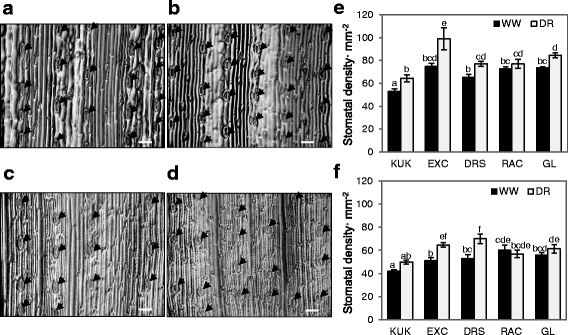
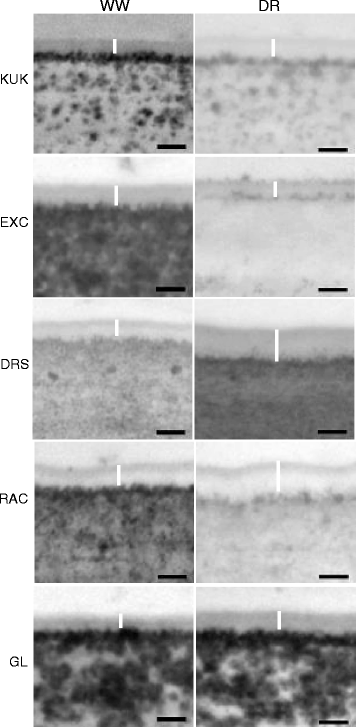
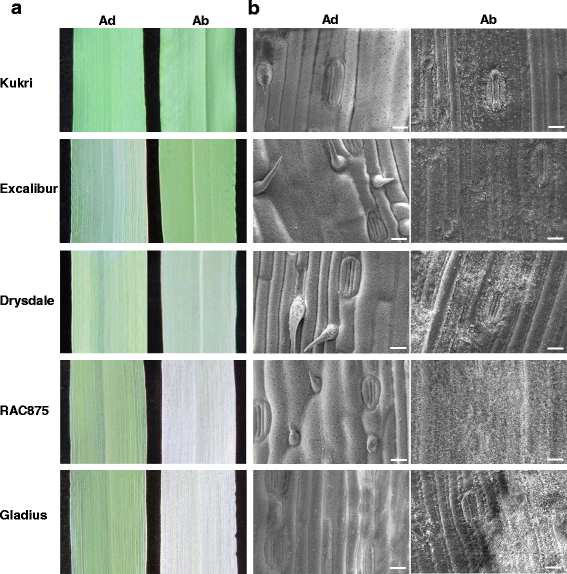
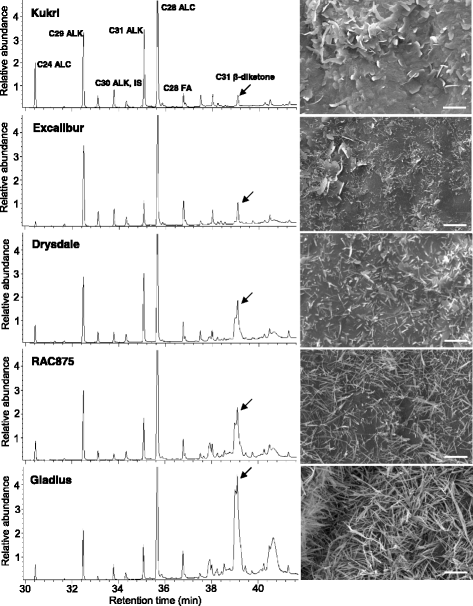
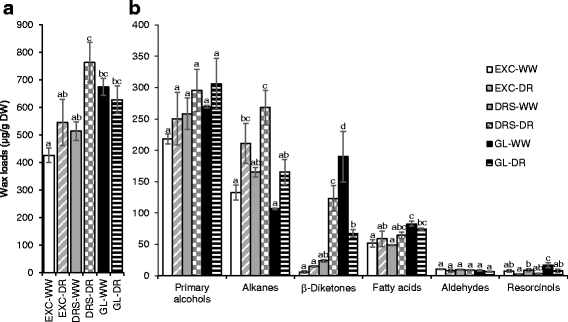
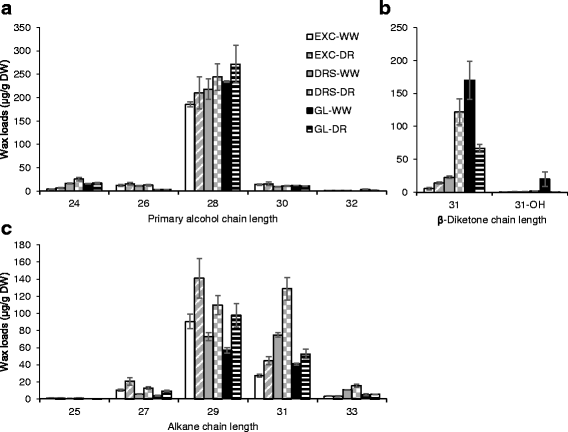
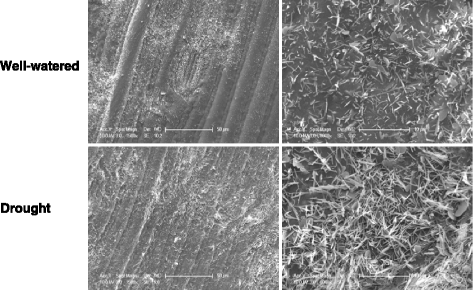
Similar articles
-
Identification and characterization of wheat drought-responsive MYB transcription factors involved in the regulation of cuticle biosynthesis.J Exp Bot. 2016 Oct;67(18):5363-5380. doi: 10.1093/jxb/erw298. Epub 2016 Aug 3. J Exp Bot. 2016. PMID: 27489236 Free PMC article.
-
A morpho-physiological approach differentiates bread wheat cultivars of contrasting tolerance under cyclic water stress.J Plant Physiol. 2014 Sep 1;171(14):1256-66. doi: 10.1016/j.jplph.2014.04.013. Epub 2014 May 17. J Plant Physiol. 2014. PMID: 25014261
-
Drought stress modify cuticle of tender tea leaf and mature leaf for transpiration barrier enhancement through common and distinct modes.Sci Rep. 2020 Apr 21;10(1):6696. doi: 10.1038/s41598-020-63683-4. Sci Rep. 2020. PMID: 32317754 Free PMC article.
-
[Plant epicuticular wax and drought resistance as well as its molecular biology].Zhi Wu Sheng Li Yu Fen Zi Sheng Wu Xue Xue Bao. 2006 Oct;32(5):505-12. Zhi Wu Sheng Li Yu Fen Zi Sheng Wu Xue Xue Bao. 2006. PMID: 17075172 Review. Chinese.
-
Transcriptional regulation of cuticle biosynthesis.Biotechnol Adv. 2014 Mar-Apr;32(2):526-40. doi: 10.1016/j.biotechadv.2014.01.005. Epub 2014 Jan 31. Biotechnol Adv. 2014. PMID: 24486292 Review.
Cited by
-
High-resolution spectral information enables phenotyping of leaf epicuticular wax in wheat.Plant Methods. 2021 Jun 7;17(1):58. doi: 10.1186/s13007-021-00759-w. Plant Methods. 2021. PMID: 34098962 Free PMC article.
-
Chemical and Transcriptomic Analyses of Leaf Cuticular Wax Metabolism in Ammopiptanthus mongolicus under Osmotic Stress.Biomolecules. 2024 Feb 16;14(2):227. doi: 10.3390/biom14020227. Biomolecules. 2024. PMID: 38397464 Free PMC article.
-
Aerosol Impacts on Water Relations of Camphor (Cinnamomum camphora).Front Plant Sci. 2022 Jun 20;13:892096. doi: 10.3389/fpls.2022.892096. eCollection 2022. Front Plant Sci. 2022. PMID: 35795349 Free PMC article.
-
High post-anthesis temperature effects on bread wheat (Triticum aestivum L.) grain transcriptome during early grain-filling.BMC Plant Biol. 2020 Apr 16;20(1):170. doi: 10.1186/s12870-020-02375-7. BMC Plant Biol. 2020. PMID: 32299364 Free PMC article.
-
Genetic analysis of water loss of excised leaves associated with drought tolerance in wheat.PeerJ. 2018 Jul 6;6:e5063. doi: 10.7717/peerj.5063. eCollection 2018. PeerJ. 2018. PMID: 30002956 Free PMC article.
References
-
- Jetter R, Kunst L, Samuels AL. Composition of plant cuticular waxes. In: Riederer M, Muller C, editors. Annual Plant Reviews Volume 23: Biology of the Plant Cuticle. Oxford: Blackwell Publishing Ltd; 2007. pp. 145–181.
Publication types
MeSH terms
Substances
LinkOut - more resources
Full Text Sources
Other Literature Sources

